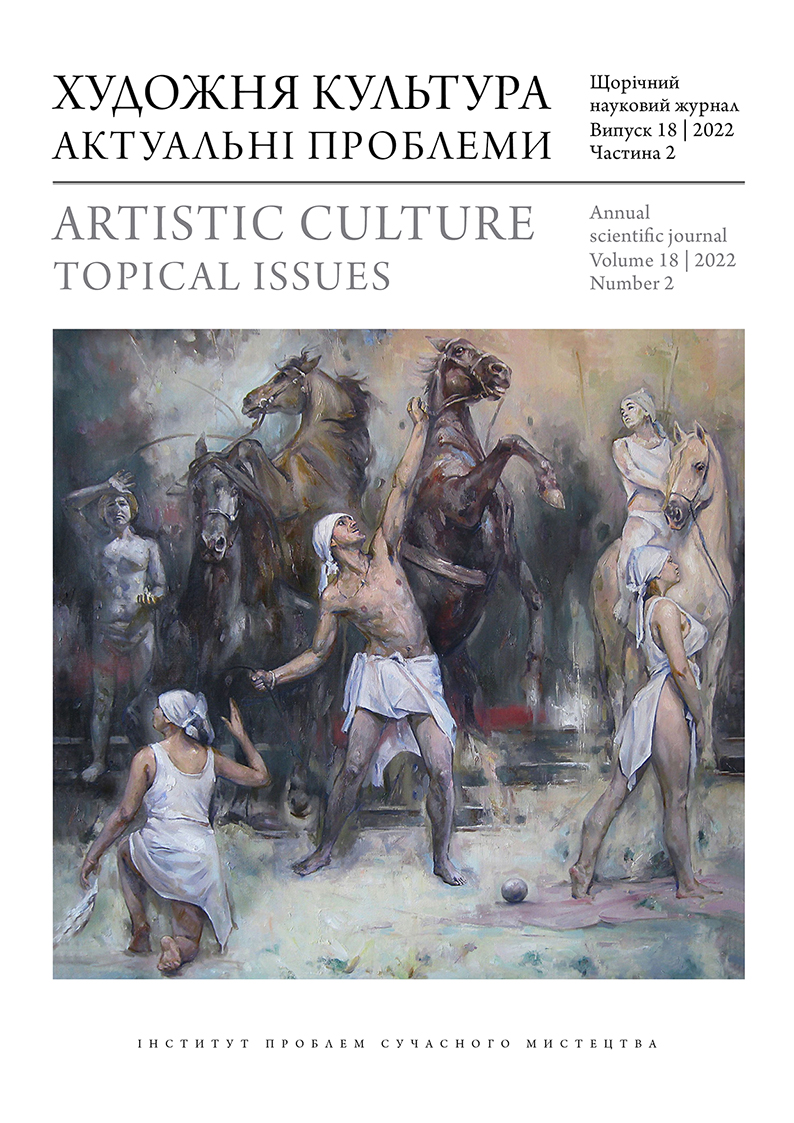Актуалізація нейроестетичних досліджень у полі сучасної екранної культури. Нейроекранологія
DOI:
https://doi.org/10.31500/1992-5514.18(2).2022.269777Ключові слова:
neuroaesthetics, screen studies, screen culture, interdisciplinarity, multimodality, cerebral activityАнотація
Розглянуто особливості чуттєво-емоційного сприйняття екранних творів глядачем з позицій нейронного відгуку— в предметному полі нейроестетики як міждисциплінарної сфери знання на перетині мистецтвознавства, філософії, психології сприйняття та нейронауки. Розкрито історичні підступи до оприявлення закономірностей зв’язку перцептуального посилу та нейтронної відповіді.
У праці окреслено теоретичне й суто практичне значення нейроестетичного знання та інноваційних методик нейродосліджень у вивченні рецепції «екранного продукту». Зокрема — при виявленні алгоритму формування вражень глядача/реципієнта — «споживача» екранної культури. За наукову гіпотезу визначено можливі вектори подальшого розвитку діалектичних зв’язків нейрологічної науки та екранології.
Посилання
Bartels, A. & Zeki, S. (2004a). Functional Brain Mapping During Free Viewing of Natural Scenes. Human Brain Mapping, 21(2), 75–85. doi: 10.1002/hbm.10153
Bartels, A. & Zeki, S. (2004b). The Chronoarchitecture of the Human Brain-Natural Viewing Conditions Reveal a Time-Based Anatomy of the Brain. Neuroimage, 22(1), 419–33. doi: 10.1016/j.neuroimage.2004.01.007
Brown, S. & Dissanayake, E. (2009) The Arts Are More Than Aesthetics: Neuroaesthetics as Narrow Aesthetics. In: Skov, M. & Vartanian, O. (Eds.). Neuroaesthetics (p. 43–57). Baywood Publishing Company.
Chatterjee, A. (2011). Neuroaesthetics: A Coming of Age Story. Journal of Cognitive Neuroscience, 23(1), 53–62. doi.org/10.1162/jocn.2010.21457
Chatterjee, A. (2014, May 1). Neuroaesthetics. Researchers unravel the biology of beauty and art. https://www.the-scientist.com/cover-story/neuroaesthetics-37572.
Chatterjee. A. & Vartanian, O. (2016). Neuroscience of aesthetics. Annals of the New York Academy of Sciences, 1369(1), 172–194. doi: 10.1111/nyas.13035
Consoli, G. (2015). From Beauty to Knowledge: A New Frame for the Neuropsychological Approach to Aesthetics. Frontiers in Human Neuroscience, 9, Article 290. doi: 10.3389/fnhum.2015.00290
Gerdes, A.B.M., Wieser, M.J., and Alpers, G.W. (2014). Emotional Pictures and Sounds: A Review of Multimodal Interactions of Emotion Cues in Multiple Domains. Frontiers in Psychology, 5, Article 1351. doi: 10.3389/fpsyg.2014.01351
Hasson, U., Landesman O., Knappmeyer, B., Vallines, I., Rubin, N. & Heeger, D.J. (2008). Neurocinematics: The Neuroscience of Film. Projections, 2(1), 1–26. doi:10:3167/proj.2008.020102.
Ishizu, T. & Zeki, S. (2011). Toward A Brain-Based Theory of Beauty. PLoS ONE 6(7), e21852. doi: 10.1371/journal.pone.0021852
Kawabata, H. & Zeki, S. (2004). Neural correlates of beauty. Journal of Neurophysiology, 91, 1699-1705. doi: 10.1152/jn.00696.2003.
Maslow, A. (2004). Motivatsiya i lichnost [Motivation and Personality], trans. A.M. Tatlybayeva. PSYLIB.
Nadal, M., & Skov, M. (2013). Introduction to the special issue: Toward an interdisciplinary neuroaesthetics. Psychology of Aesthetics, Creativity, and the Arts, 7(1), 1–12. doi: 10.1037/a0031842
Oliver, V.B. & Hartman, T. (2010). Exploring the role of meaningful experiences in users’ appreciation of “good movies.” Projections: The Journal of Movies and Mind, 4(2), 128–150. doi: 10.3167/proj.2010.040208
Pourtois, G. & Dhar, M. (2013). Integration offace and voice during emotion perception: isthere anything gained for the perceptual system beyond stimulus modality redundancy. In Belin, P., Campanella, S., & Ethofer, T. (Eds.) Integrating Face and Voice in Person Perception, (pp. 181–206). Springer. doi: 10.1007/978-1-4614-3585-3_10
Ramachandran, V. S. (2003). The Emerging Mind (Reith Lectures). Profile Books.
Ramachandran, V. S., & Hirstein, W. (1999). The Science of Art: A Neurological Theory ofAesthetic Experience. Journal of Consciousness Studies, 6(6–7), 15–51.
Sigman, M. (2017). The Secret Life of The Mind: How Your Brain Thinks, Feels, and Decides. Little, Brown and Company, 2017.
##submission.downloads##
Опубліковано
Як цитувати
Номер
Розділ
Ліцензія

Ця робота ліцензується відповідно до Creative Commons Attribution-NonCommercial-ShareAlike 4.0 International License.
Автори, які публікуються у цьому журналі, погоджуються з наступними умовами:
1. Автори залишають за собою право на авторство своєї роботи та передають журналу право першої публікації цієї роботи на умовах ліцензії Creative Commons Attribution License, котра дозволяє іншим особам вільно розповсюджувати опубліковану роботу з обов'язковим посиланням на авторів оригінальної роботи та першу публікацію роботи у цьому журналі.
2. Автори мають право укладати самостійні додаткові угоди щодо неексклюзивного розповсюдження роботи у тому вигляді, в якому вона була опублікована цим журналом (наприклад, розміщувати роботу в електронному сховищі установи або публікувати у складі монографії), за умови збереження посилання на першу публікацію роботи у цьому журналі.
3. Політика журналу дозволяє і заохочує розміщення авторами в мережі Інтернет (наприклад, у сховищах установ або на особистих веб-сайтах) рукопису роботи, як до подання цього рукопису до редакції, так і під час його редакційного опрацювання, оскільки це сприяє виникненню продуктивної наукової дискусії та позитивно позначається на оперативності та динаміці цитування опублікованої роботи (див. The Effect of Open Access.


